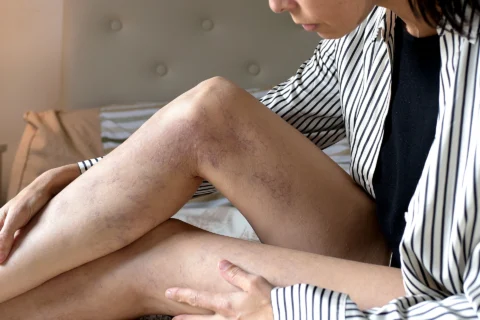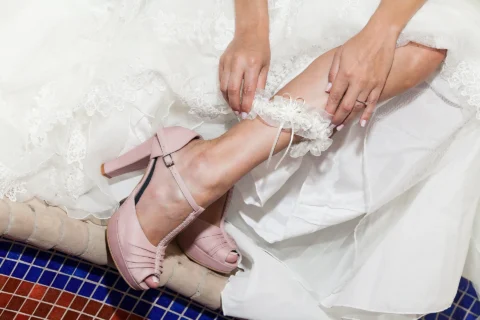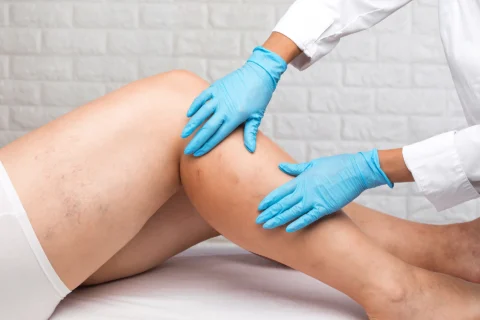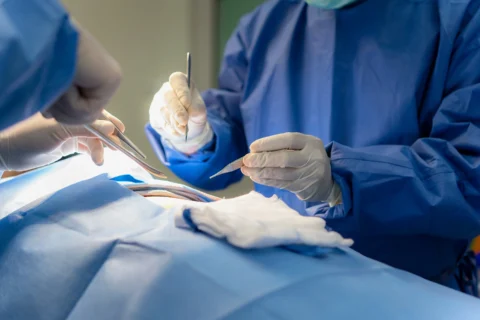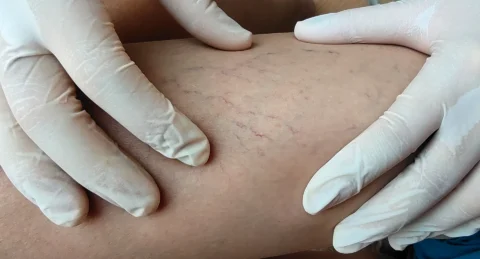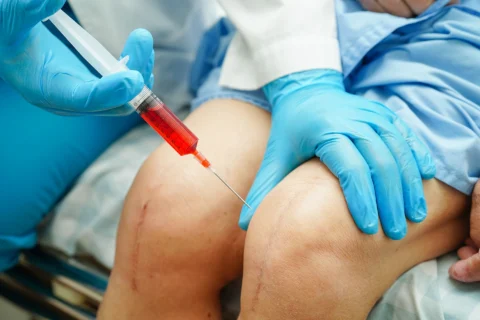While varicose veins are harmless, many people seek out treatments to have them removed for cosmetic purposes. Varicose veins often appear on the body in areas that have poor blood flow, causing blood clots and visible veins near the skin’s surface to appear. These veins take on a branched-out or spider-like formation which are typically blue, red, or purple in color. With the demand for varicose vein removal treatments rising in the cosmetic world, experts in the field have created numerous methods to permanently eliminate varicose veins, one of which being varicose vein shots or sclerotherapy.
So how long would it take for the varicose vein shots to be effective? The answer is it truly depends. Several factors like size, number of veins, and amount of sessions will affect the time it takes for the sclerotherapy to provide visible results. For smaller superficial veins, it may only take 3 to 6 weeks but larger deeper veins may take months until you get your desired results. While varicose vein shots don’t offer immediate results, it’s important to remember that the sclerotherapy treatment was designed to be highly effective and will eventually get rid of your varicose and spider veins permanently.
Learn More: Are Varicose Veins Genetic?
How Varicose Vein Shots Work
When varicose vein shots are administered to both superficial and deep veins, a solution is injected forcing them to collapse and close themselves off. Due to this, blood will no longer be able to pass through or pool in your blood vessels. Eventually, the nonfunctional vein will be absorbed by the body, getting rid of any signs of varicose and spider veins on your body.
When Do Varicose Vein Shots Take Effect?
Varicose vein shots and sclerotherapy could take anywhere from 3 weeks to 4 months for you to see the effects after your final session. Though this may seem like a long time, the solution used in sclerotherapy was designed to safely and gradually allow your varicose veins to collapse and have it slowly absorbed into tissue cells nearby. Little by little you should notice your varicose veins become less prominent and pigmented each week until they’re no longer visible.
To manage expectations, it’s also important to note that the effect of sclerotherapy will take place after the final procedure. Many people expect varicose vein shots and sclerotherapy to be a one-time procedure, however, oftentimes around 3 to4 additional treatments will be required to really get rid of your varicose and spider veins.
The number of treatments you’ll need will depend on the size and amount of varicose veins you need to be removed. For larger veins, it’s more likely that you’ll need more sessions to completely remove them. After all sessions have been completed, you should have healthy veins that don’t form blood pools or have any blood clotting that may result in the recurrence of varicose veins.
How Long Does The Actual Procedure Take?
Before the procedure, it is advised that you avoid any hair removal treatments on the treatment site and stop applying lotion at least a day before. To get a better visual of your varicose veins, prior to injecting the solution your doctor may also require an ultrasound to map out the vein composition. This will help the injection placement be more accurate and provide better end results after the treatment.
If you have any pre-existing conditions or are currently on medication, this would also be a great time to discuss them with your doctor. While this procedure is safe for the general population, pre-existing conditions and medication may require slight changes or alterations to prevent damage to nerves and keep you healthy throughout the treatment and recovery. Here are some medications that you should avoid before your treatment:
Medications to Avoid Before Sclerotherapy
Not all medications are recommended especially when you’re having your varicose veins removed. Some medications you should avoid include antibiotics, blood thinners and anti-inflammatory medicines, as well as prednisone. It’s best to consult with your physician to know which medications in particular you are allowed to take.
1) Antibiotics
It ‘s not recommended that you take any antibiotic treatment the day leading up to your sclerotherapy session. Antibiotics may cause complications like skin staining once the solution has been injected. Certain antibiotics also contain blood-thinning properties which could cause internal bleeding after the procedure. If you’re in the middle of an antibiotics cycle, it would be best to consult your doctor or reschedule your appointment.
2) Blood Thinner and Anti-Inflammatory Medicines
Two days before your treatment, anti-inflammatory and blood-thinning medicines like Advil should be avoided at all costs. Their anti-inflammatory and blooding-thinning properties could negatively affect the solution used in Sclerotherapy and prevent blood clots. Not only will this prevent the varicose vein from collapsing and disappearing but it could also cause internal bleeding and promote increased blood flow after the procedure.
3) Prednisone
If you’re currently taking prednisone, it would be best to stop taking them at least two days before getting the varicose vein shots. Prednisone has been found to negatively react with the solution used in sclerotherapy making it less effective in removing varicose veins.
Administration of the Varicose Vein Solution
As a non-surgical procedure, sclerotherapy can be done rather quickly in 30 minutes or less. When you enter the doctor’s office, the treatment area will be disinfected with alcohol to avoid bacteria and possible infection. Once the area is prepped, the varicose vein solution will be injected through a small needle directly into your problematic veins.
This will be done a number of times depending on the formation and amount of the varicose veins on your body. After the solution has been injected into the veins, pressure will be applied to the pressure to prevent the flow of blood within the area. Your doctor will then massage the area to help the solution disperse onto the area better.
The administration of varicose vein shots also does not require the use of anesthesia. However, if you’re sensitive to needles, consult your doctor on possible local anesthetics that can be used to make the treatment more pleasant and comfortable for you.
Learn More: A Complete Guide to Your Non Surgical Varicose Vein Treatment
Repetition
With sclerotherapy requiring multiple sessions to take full effect, most patients will need at least 3 to 4 treatments of varicose vein shots. While it might be tempting to have back-to-back procedures, after each session your body will need time to heal and recover before the solution can be injected again.
It’s suggested that you book your sclerotherapy sessions a couple of weeks or even a month apart to ensure that you have healthy veins and can withstand the following treatments. With each treatment, you should notice gradual improvements to your superficial veins after a few days of the procedure.
Though sclerotherapy is quite a lengthy process with more than one session required, it does offer great results to patients seeking to remove their visible dark veins. After a couple of sclerotherapy treatments, it has been shown that at least 80% of the solution-treated blue varicose veins did in fact collapse and disappear from patients’ skins. In addition to this, sclerotherapy provides permanent results, as it has been shown that varicose veins that disappeared due to the treatment are unlikely to reappear.
Recovery Time
While it has been mentioned earlier that you will need to space out your sclerotherapy session to ensure proper recovery, there is no need for you to be completely sedentary during that time. Unlike other procedures, there is no risk in driving yourself to and from the treatment center.
Right after your sclerotherapy session, you may be asked to wear compression stockings or any compression garment to help support your veins but other than that, you should be able to resume your daily activities and usual schedule without any risk of pain or discomfort.
In addition to your normal activities, taking light walks and participating in low-impact physical activity after your session is recommended to help you strengthen vein walls and have healthier veins during recovery. Within 2 to 4 weeks your body should be fully recovered from your previous sclerotherapy session and ready for the next round of varicose vein shots.
Possible Side Effects of Conventional Sclerotherapy

While sclerotherapy is generally safe for everyone, there are some side effects that could arise after the procedure. The most common complications of sclerotherapy Include:
1) Swelling
Due to the needle and solution used in Sclerotherapy, it is possible that the incision site will develop some swelling after the procedure. This is due to the fact that the solution agitates the varicose veins and causes the area to become inflamed. The swelling should go down soon after the procedure is done or up to 14 days after surgery at most.
2) Hardening of Veins
While it’s unlikely for smaller veins to harden from the sclerotherapy solution, larger varicose veins do run the risk of reacting this way. When larger varicose veins get injected with the solution, it is possible that it will cause a reaction wherein it will swell and a hard lump is formed at the treatment site. While not a regular side effect, it shouldn’t be a cause for concern and will subside over a period of time.
3) Bruising
Bruising and skin discoloration normally occur after sclerotherapy and should subside a few days after surgery. If the bruises persist, arnica extract has been said to be an effective topical treatment to help the bruising. If bruising continues, it would be best to contact your doctor to see if any underlying complications or venous diseases may be present.
4) Allergic Reactions
The solution used in sclerotherapy can generally be accepted by anybody without complications. However, in rare cases, patients may find that they have an allergic reaction to the solution. It’s unlikely that your allergic reaction to the solution will result in any longer-term medical conditions, at most the area will swell and itch for a couple of hours after the treatment.
If any side effects last longer than a few days or weeks, please contact a health provider and set up an appointment to ensure that the sclerotherapy did not cause any issue or complications that may be hazardous to your health.
Alternative Procedures To Sclerotherapy
If regular sclerotherapy makes you uncomfortable or isn’t advised by your physician, then you can explore your other options like foam sclerotherapy and laser varicose vein surgery. For best results, it’s recommended that you weigh your choices with your trusted provider so you can account for the pros and cons of each procedure and pick one that feels right to you.
1) Foam Sclerotherapy
Similar to conventional sclerotherapy, foam sclerotherapy uses injections to administer a solution to your varicose veins. The main difference lies in the fact that foam sclerotherapy uses foam sclerosant rather than the regular sclerosant solution in liquid form. You may want to consider this type of sclerotherapy if you have larger varicose veins as the foam solution is more effective in diminishing them. The procedure itself lasts 30 to 40 minutes and should have minimal side effects afterwards. In 3 to 4 months after the minor surgery, your problematic veins should have fully collapsed and no longer be visible on your skin.
2) Laser Varicose Vein Surgery
Making use of Lasik technology, laser therapy uses heat and high temperatures to remove blue varicose veins from your skin surface. What laser surgery basically does is transmit heat to your varicose veins causing them to close up and scare, preventing the flow of blood. Once the vein is no longer functional, it will be absorbed into the nearby tissue cells consequently getting rid of your varicose veins. While you will need to have someone drive you to and from the doctors’ appointment, laser surgery is one of the most painless invasive treatments you can get and will give you results within 2 to 3 weeks.
Read More: Facial Varicose Veins: What You Need to Know
Get Fast-Acting Solutions for All Your Vein Concerns at Vein Center Doctor

Here at Vein Center Doctor, our team of highly-skilled experts perform vein removal treatments swiftly and effectively almost every day. With our top-of-the-line methods and procedures from compression stockings therapy to endovenous laser treatment, we offer our patients safe and result-driven treatments sure to remove their varicose veins permanently.
Say hello to clear, smooth, and vein-free skin with us. If you have a venous condition that you would like to treat or preventative methods you’d like to practice, contact us for consultations or book an appointment now.


